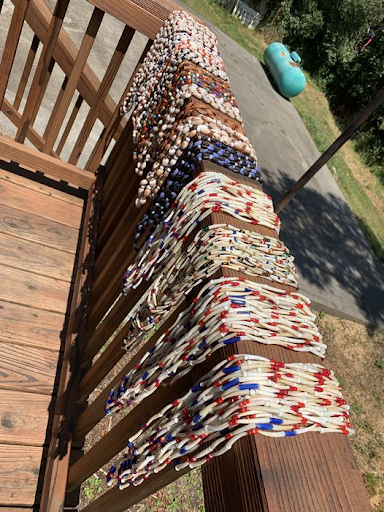Overview
Math and Value, Hoopa Math

Author: Liz Lewis
Expert Contributors: Novi McCovey (Hupa/Yurok/Karuk), Kristi Lewis (Hupa).
Curriculum partner: Rebecca Lowry, Humboldt County Office of Education.
Grades: K-5
Suggested Amount of Time: Three 20-30 min lessons
Part I What is Math?
Part II: Multicultural Math
Part III: Native American Math- Hoopa Math
Curriculum Themes:
- History
- Cultural Strengths
- Relationship to Place
- Cross Curricular Integration
Learning Goals
Students will learn how:
- Different cultures, including Hupa people, model and count
- Hupa people use tools to solve problems strategically
- Traditional value is considered (mathematical and cultural) in Hupa culture
Students will:
- Understand what math is and that different groups of people have used concepts of math to represent and understand the world
- Relate digits and counting to understand concepts of value
- Identify Hoopa Values, how Hoopa people measure or represent value and trade or preserve value
Unit Overview
This math unit relates to standards of place value and counting. Teaching students other number systems and concepts of value helps them to better understand base 10 and their own counting/ number systems. This lesson opens math up beyond the typical addition/ subtraction/ multiplication/ division and relates closer to the Common Core based Standards for Mathematical Practice (K-12). By introducing students to multicultural math and the Hupa people, you may find students connecting to math in a deeper, more complex way after this lesson. They may also share with you personal connections as they begin to see their own cultural values as a part of math for the first time. This lesson is simple but presents Math from many different cultures as a way students can better understand concepts of math in general. By exploring counting with the Hupa people of Northwest California, students will also gain a deeper understanding of how math and culture are connected. They will learn about the culture of the Hupa people by understanding how and why they traditionally would count and use math. Students can compare this to their own lives to better understand why they, themselves, need to count and use math.
This lesson also connects to the 2023 Mathematics Framework adopted July 12, 2023 by the State Board of Education. Specifically, this lesson does work to expand equity and engagement in the field of math to students who may not traditionally feel a cultural connection to math. Please visit https://www.cde.ca.gov/ci/ma/cf/ for more details on the Math Framework.
Essential Questions:
- What is math?
- How have different groups of people used concepts of math to represent and understand the world?
- How do digits and counting help us to understand value?
- What do different cultures value? How do they measure value?
Teacher Background
Before colonization, Native American people across California had unique counting and number systems, which they used to solve problems, trade and keep track of small and large numbers. The Pomo Natives in Mendocino County, for example, had 7 different unique languages which included multiple completely different number systems. With colonization came huge losses of life/ cultural items/ ceremonies and more, and the number systems of Native people throughout California have often been overlooked, disrespected and forgotten. However, many people and cultures have survived. Language revitalization has allowed for a new generation to use technologies and other tools to maintain cultural values. This lesson explores through language and counting the value and mathematics of the Hupa people. The Hoopa Valley tribe is located in Northwestern California and maintains its tribal sovereignty today. Prior to colonization, the Hupa people traded with other Native People in the area, such as the Yuroks and Karuks. They also used complex trade routes to participate in extensive trade across multiple nations and what is now called the Continental United States. Prior to colonization, they had rich lives full of ceremony, family and unique customs. They maintained themselves through hunting, fishing and gathering and maintained a complex political organization as a tribal nation. As you will see in the interviews in this lesson, you can not understand Hoopa math without learning about Hoopa ways of ownership, ceremonial practices, family values, connection with nature and even burial practices. Math is a language to understand the world. To understand Hoopa math, students will learn about the values of Hoopa people, words used for counting, and more.
The teacher must understand that Native American people have different values related to ownership and thus have unique ways of counting, representing and managing items.
The teacher must be prepared to actively engage students' understanding of math with an open mind for multicultural mathematical methods.

